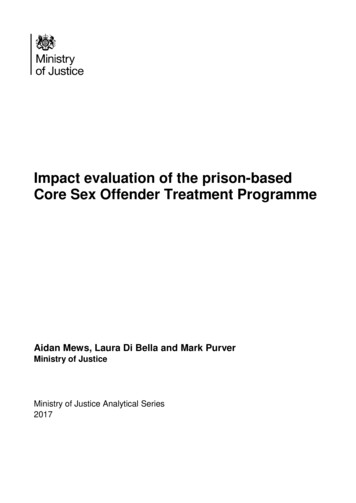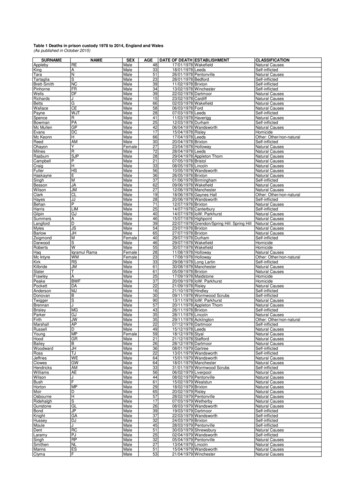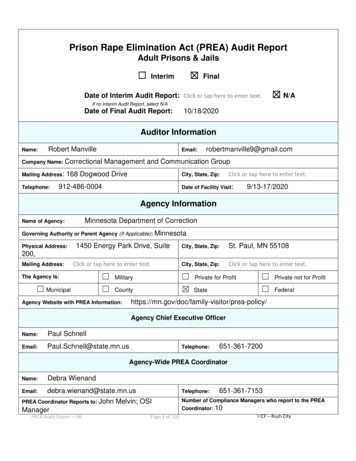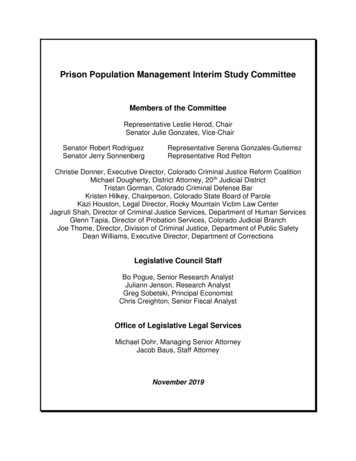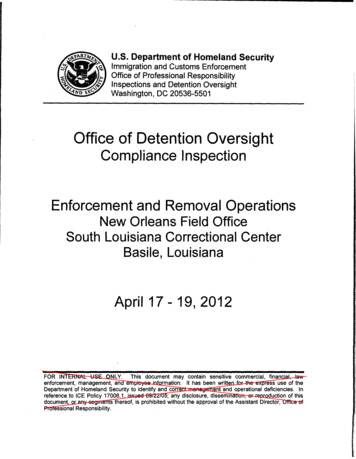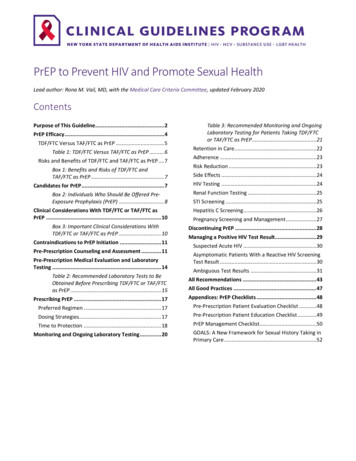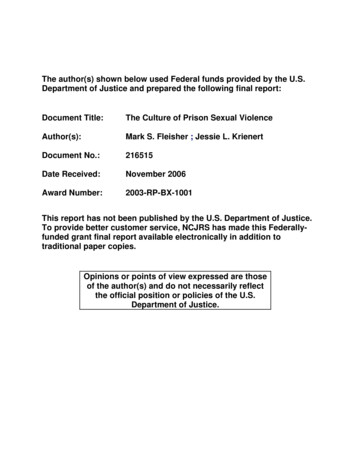
Transcription
The author(s) shown below used Federal funds provided by the U.S.Department of Justice and prepared the following final report:Document Title:The Culture of Prison Sexual ViolenceAuthor(s):Mark S. Fleisher ; Jessie L. KrienertDocument No.:216515Date Received:November 2006Award Number:2003-RP-BX-1001This report has not been published by the U.S. Department of Justice.To provide better customer service, NCJRS has made this Federallyfunded grant final report available electronically in addition totraditional paper copies.Opinions or points of view expressed are thoseof the author(s) and do not necessarily reflectthe official position or policies of the U.S.Department of Justice.
THE CULTURE OF PRISON SEXUAL VIOLENCEMARK S. FLEISHER, PH.D.CASE WESTERN RESERVE UNIVERSITYJESSIE L. KRIENERT, PH.D.ILLINOIS STATE UNIVERSITYTHIS REPORT WAS PREPARED FOR THE NATIONAL INSTITUTE OF JUSTICETHROUGH GRANT NUMBER 2003-RP-BX-1001OPINIONS EXPRESSED IN THIS DOCUMENT DO NOT REPRESENT THEOFFICIAL POSITION OR POLICIES OF THE NATIONAL INSTITUTE OF JUSTICE,CASE WESTERN RESERVE UNIVERSITY AND ILLINOIS STATE UNIVERSITYOR ITS TRUSTEES.Correspondence or inquiries should be addressed to Dr. Fleisher, 216-269-7348,msfleisher@gmail.comThis document is a research report submitted to the U.S. Department of Justice. This report has notbeen published by the Department. Opinions or points of view expressed are those of the author(s)and do not necessarily reflect the official position or policies of the U.S. Department of Justice.
2TABLES . 7FIGURES. 9CHAPTER 1. HISTORICAL PERSPECTIVES ON PRISON CULTURE ANDSEXUAL VIOLENCE RESEARCH. 19EARLY DECADES OF PRISON SEX RESEARCH . 201930S TO 1950S . 20EARLY DECADES: SUMMARY OF KEY FINDINGS . 27MIDDLE DECADES OF PRISON SEX RESEARCH. 281950S TO 1970S . 28Influences of World War II on the conceptualization of prison culture . 28SYKES’S INFLUENCE ON THE FUTURE OF PRISON INTELLECTUAL THOUGHT . 32MIDDLE DECADES: SUMMARY OF KEY FINDINGS . 39MODERN DECADES OF PRISON SEX RESEARCH . 411980S TO 2000S . 41THEORETICAL APPROACHES TO INMATE SEXUAL BEHAVIOR. 45Importation vs. Deprivation. 45Goffman’s Dramaturgical Sociology . 46Race, ethnicity, and aggression . 48Fear of sexual assault . 49MODERN DECADES: SUMMARY OF KEY FINDINGS . 51RESEARCH LITERATURE ON WOMEN INMATES. 51Pseudo-families. 53Women inmates’ homosexuality. 54Sexual Coercion and Rape. 54Definitional Issues . 55Prison socialization: pseudo-family vs. the mix. 55Institutional Factors. 57Research limitations. 57Final Comments . 58CHAPTER 2. RESEARCH DESIGN AND METHODOLOGY . 59WHAT THIS RESEARCH DID NOT DO . 59INFLUENCE OF CLEMMER’S THEORY OF CULTURE ON METHODOLOGY . 60This document is a research report submitted to the U.S. Department of Justice. This report has notbeen published by the Department. Opinions or points of view expressed are those of the author(s)and do not necessarily reflect the official position or policies of the U.S. Department of Justice.
3PRIMARY THEORETICAL-ANALYTIC CONCEPTS. 61Prison Speech Community . 61Clemmer’s Supra-Individual Theory of Culture . 63GATHERING LANGUAGE AND CULTURE DATA. 64ETHNOGRAPHIC VS. NON-ETHNOGRAPHIC QUERIES . 64Nature of ethnographic questions . 64PROJECT SET-UP . 66Developing a methodology. 66Correctional institution site selection . 67Research Team. 70In the field: asking former inmates about prison sex . 71Office interviews with former inmates . 73Testing the instrument in prison. 74INSTRUMENT DEVELOPMENT: INFLUENCES FROM PREVIOUS RESEARCH . 76Conceptual findings . 77Substantive findings . 78FINAL INTERVIEW INSTRUMENT: DESCRIPTIVE CATEGORIES . 78INTERVIEW INSTRUMENT: CATEGORICAL STRUCTURE . 79Interview instrument: significance in the order of question categories . 82INMATE SAMPLING DESIGN . 83Limitations of sampling design . 84Informed Consent Process . 86Unanticipated events. 88Interview guidelines . 88ANALYSIS. 90RECURRING “PIECES” OF PRISON-RAPE KNOWLEDGE . 90Significance of cultural information . 91Data collection. 92Computer aided qualitative analysis. 93Transferring data to Atlas/ti . 94Advantages of the Atlas/ti Method . 94Weaknesses of Atlas/ti. 95CODES AND CODING . 95STRUCTURAL AND THEMATIC CODES . 96Structural codes . 96Thematic codes . 97Coding process . 98Data Entry and Verification. 100Themes and cultural significance . 101THEMES. 101SUBSTANTIVE AND CONCEPTUAL THEMES . 102Substantive themes . 102This document is a research report submitted to the U.S. Department of Justice. This report has notbeen published by the Department. Opinions or points of view expressed are those of the author(s)and do not necessarily reflect the official position or policies of the U.S. Department of Justice.
4Conceptual themes . 103Simple conceptual themes . 103Abstract cultural themes . 103Validity. 104CHAPTER 3. SOCIO-CULTURAL AND VERBAL DYNAMICS OF SEXUALVIOLENCE. 105DIFFERENTIAL PRISONIZATION: IMPORTATION OF DIVERSITY OF PRISON CULTURE KNOWLEDGE . 108Inmate Socio-Demographics. 108Verbal Exposure to Sexual Victimization. 114“For-sure” knowledge of prison rape . 116“Heard about” prison rape . 118Threats of and worry about prison rape . 120Exposure to Media-like Portrayals of Prison Rape . 124Urban mythology . 126PRISONIZATION: VERBAL LESSONS OF SOCIALIZATION . 131DIFFERENTIAL PRISONIZATION: INTEGRATION OF VERBAL SOURCES OF KNOWLEDGE . 132CULTURAL CONSTRUCTION OF SEXUAL ASSAILANTS . 134Rapist . 135Turn-out artist. 140Rapist vs. bootie bandit. 142PRISON CULTURE’S SEXUAL WORLDVIEW . 144A CAUTIONARY NOTE TO READERS . 144CULTURE OF PRISON HOMOSEXUALITY AND SEXUAL VIOLENCE . 145INMATES’ SUBJECTIVE PERCEPTION OF PRISON SEXUALITY . 147INNER HOMOSEXUAL . 147Cultural interpretation of sexual identity. 149Cultural symbolism of the inner homosexual. 151INMATE CULTURE’S WORLDVIEW ON SEXUAL VIOLENCE . 153CHAPTER 4. THE CULTURE OF SEXUAL VICTIMIZATION. 158PRISON SEXUAL CULTURE . 159Sexualizing prison culture. 159IN-PRISON SEXUAL ROLE TRANSFORMATION . 164SEXUAL ASSAULT: JUDGMENT OF AN INMATE JURY . 168ENTITLEMENT TO SEXUAL VIOLENCE . 170PERSONAL DEBTS . 174SOCIAL CONSEQUENCES OF VICTIMIZATION . 176“NO REASON FOR RAPE” . 177VICTIM’S INTERPRETATION OF SEXUAL ASSAULT . 183SAFE ZONES. 185This document is a research report submitted to the U.S. Department of Justice. This report has notbeen published by the Department. Opinions or points of view expressed are those of the author(s)and do not necessarily reflect the official position or policies of the U.S. Department of Justice.
5Cultural forms of vulnerability . 186CULTURAL FORMS OF SELF-PROTECTION. 187SOCIAL ISOLATION: AVOIDING THE SEX SCENE . 187AGGRESSIVE POSTURES. 189Violence . 189Physical Strength . 192PROTECTIVE VALUE OF PARTNERS AND COMPANIONS . 192Schooling . 194Closeness to Staff . 194FAMILY, FRIENDS, AND LOVERS: SOCIAL AND INTIMATE RELATIONS . 195Friends and family . 195Domestic relations . 197Domestic violence . 201Gangs. 202Religious group affiliation . 204CULTURAL DISTINCTIVENESS AMONG ACTS OF PRISON SEX . 207Mutual sex. 208Degrees of sexual pressure . 208Sexual violence . 210Summary: distinctive cultural characteristics of sexual acts . 211CHAPTER 5. MANAGEMENT OF PRISON SEXUAL VIOLENCE . 212INMATES’ PERCEPTIONS OF THE MANAGEMENT OF INMATE SEXUALBEHAVIOR. 213Salience of cultural knowledge . 213STAFF VERBAL MESSAGES ABOUT SEXUAL BEHAVIOR AND SEXUAL VIOLENCE . 214STAFF INFLUENCE ON SEXUAL CONDUCT AND INSTITUTION PRACTICES OF SOCIAL CONTROL . 220VISUALIZATIONS OF INMATES’ PERCEPTIONS OF KEY MANAGEMENTISSUES . 229CORRECTIONAL PRACTICE RECOMMENDATIONS . 230COMMISSARY EXPENDITURE ANALYSIS . 233INCIDENT REPORT ANALYSIS . 234HOUSING-UNIT SUPERVISION . 236Focused shakedowns. 241Observation logs . 242ANALYSIS OF INMATES’ MANAGEMENT PERCEPTIONS . 242INMATE ORIENTATION. 242WRITTEN SEXUAL PRESSURE GUIDELINES . 243CORRECTIONAL OFFICERS TALK ABOUT PRISON RAPE . 246INMATES REPORTING RAPE TO CORRECTIONAL OFFICERS . 247CORRECTIONAL OFFICER-INMATE SEXUAL AFFAIRS . 248CORRECTIONAL OFFICERS ABILITY TO PREVENT INMATE SEXUAL AFFAIRS . 248CORRECTIONAL OFFICERS’ TRYING TO PREVENT INMATE-ON-INMATE RAPE . 251This document is a research report submitted to the U.S. Department of Justice. This report has notbeen published by the Department. Opinions or points of view expressed are those of the author(s)and do not necessarily reflect the official position or policies of the U.S. Department of Justice.
6CORRECTIONAL OFFICER-ON-INMATE SEXUAL ASSAULT . 255INMATES’ FALSE RAPE ALLEGATIONS AGAINST CORRECTION STAFF . 257POLICY RECOMMENDATIONS FOR CORRECTIONAL PRACTICE . 261REFERENCES . 268APPENDIX A: LEXICON OF THE CULTURE OF PRISON SEX . 277APPENDIX B: INTERVIEW PROTOCOL. 299APPENDIX C: SAMPLING PROCEDURE. 310APPENDIX D: PROTOCOL MODIFICATION . 312APPENDIX E: THEMATIC CODEBOOK . 316APPENDIX F: SPSS CODEBOOK . 322This document is a research report submitted to the U.S. Department of Justice. This report has notbeen published by the Department. Opinions or points of view expressed are those of the author(s)and do not necessarily reflect the official position or policies of the U.S. Department of Justice.
7TablesTable 1 Demographics and Offense Statistics . 110Table 2 Sampled Inmates' Marriage History and Pre-imprisonment Sexual Preferences. 112Table 3 Inmates’ Perceptions of For-Sure Knowledge of Prison Rape by Gender and 117Table 4 Inmates’ Perceptions of For-Sure Knowledge of Prison Rape by Gender and 117Table 5 Inmates’ Perceptions of Hearing about Prison Rape by Gender and Time Served5yrs. 119Table 6 Inmates’ Perceptions of Hearing about Prison Rape by Gender and Time Served10yrs. 120Table 7 Inmates’ Perceptions of Threats and Worry about Prison Rape by Gender andTTime Served-5yrs. 122Table 8 Inmates’ Perceptions of Threats and Worry about Prison Rape by Gender andTime Served-10yrs. 123Table 9 Inmates’ Perceptions of Media-like Portrayals of Prison Rape by Gender andTime Served-5yrs. 125Table 10 Inmates’ Perceptions of Media-like Portrayals of Prison Rape by Gender andTime Served-10yrs. 125Table 11 Exposure to Prison Rape Urban Myths by Gender and Time Served, 5yrs. 127Table 12 Exposure to Prison Rape Folklore Urban Myths by Gender and Time Served,10yrs. 128Table 13 Inmates’ Reports of Knowing a Rapist Killed in Prison-5yrs. . 136Table 14 Inmates’ Reports of Knowing a Rapist who was Killed in Prison-10yrs . 136Table 15 Inmates’ Perceptions of Turn-out vs. Rape by Gender and Time Served, 5yrs. 140Table 16 Inmates’ Perceptions of Turn-out vs. Rape by Gender and Time Served, 5yrs. 141Table 17 Pre-Imprisonment Sexual Preference and Sexual Experience by Gender. 160Table 18 Pre-Imprisonment Sexual Preference and Experience by Length of TimeServed-5yrs . 162Table 19 Male Inmates by Time Served, More and Less than 10 years. 163Table 20 Estimated Sexual Preference for 100 General Population Inmates . 165Table 21 Estimates of Sexual Orientation by Time Served-5yrs. 166Table 22 Estimates of Sexual Orientation by Time Served-10yrs. 167Table 23 Inmates’ Perceptions of Rapists’ Entitlement to Commit Sexual Assault byGender and Time Served, 5yrs. 172Table 24 Inmates’ Perceptions of Rapists’ Entitlement to Commit Sexual Assault by. 173Table 25 Inmates’ Perceptions of Rape Victim’s Companions’ Retaliation by Gender andTime Served-5yrs. 181Table 26 Inmates’ Perceptions of Rape Victim’s Companions’ Retaliation by Gender andTime Served-10yrs. 182Table 27 Inmates’ Perception of the Use of Kinship Terms by Gender and Time Served,5yrs. 196Table 28 Inmates’ Perception of the Use of Kinship Terms by Gender and Time Served,10yrs. 197This document is a research report submitted to the U.S. Department of Justice. This report has notbeen published by the Department. Opinions or points of view expressed are those of the author(s)and do not necessarily reflect the official position or policies of the U.S. Department of Justice.
8Table 29 Inmates’ Perceptions of Staff Verbal Messages by Gender . 216Table 30 Men Inmates’ Perceptions of Staff Verbal Messages by Time Served-5yrs . 219Table 31 Women Inmates’ Perceptions of Staff Verbal Messages by Time Served-5yrs. 220Table 32 Inmates’ Perceptions of Management Responses by Gender. 222Table 33 Men Inmates’ Perceptions of Management Responses by Time Served-5yrs 223Table 34 Women Inmates’ Perceptions of Management Responses by Time Served-5yrs. 225Table 35 Men Inmates’ Perceptions of Management by Time Served-10yrs . 226Table 36 Women Inmates’ Perceptions of Management by Time Served-10yrs . 228Table 37 Inmates’ Perceptions of Correctional System’s Ability to Protect Inmates fromRape by Gender and Time Served-5yrs .
the culture of prison sexual violence mark s. fleisher, ph.d. case western reserve unive




